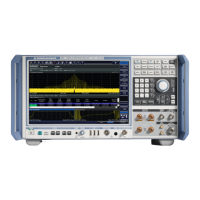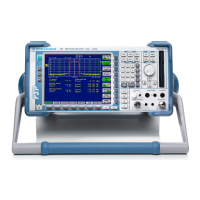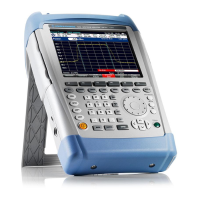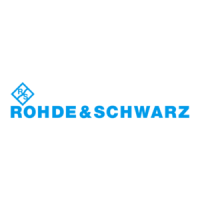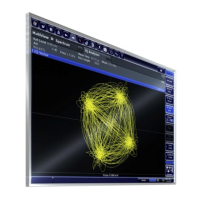
Do you have a question about the Rohde & Schwarz FSW Series and is the answer not in the manual?
| Brand | Rohde & Schwarz |
|---|---|
| Model | FSW Series |
| Category | Measuring Instruments |
| Language | English |
Provides information specific to the Analog Demodulation application and general instrument functions.
Step-by-step guide on how to activate the Analog Demodulation application on the R&S FSW.
Explains that all evaluations are based on acquired I/Q data and determined by demodulation bandwidth.
Describes the software demodulator's main processor operation and calculation processes.
Details the overload protection mechanism for the RF input connector to prevent instrument damage.
Describes the default parameters passed on from the currently active application upon first activation.
Details how to configure the trigger source for measurements, including various signal types and external triggers.
Defines which parts of the input signal are acquired and demodulated, configured via BW key or Bandwidth tab.
Defines the basic measurement parameters configured in the 'Demod' tab of the 'Demodulation Settings' dialog box.
Settings for AF evaluations, covering deviation per division and reference value settings.
Configures the output to special connectors for other devices, including trigger signals and digital I/Q output.
Activates all automatic adjustment functions for current measurement settings, including frequency, level, and scaling.
Allows configuration of up to 6 individual traces, including mode, detector, and trace linking.
Defines criteria for searches, such as peak detection, influencing search results.
Manages limit lines via the 'Line Config' dialog box, allowing creation, editing, and deletion.
Describes import and export functions available via softkeys in the Save/Recall menu.
Explains the impact of incorrect demodulation bandwidth on measurement accuracy and results.
Introduces SCPI commands, their syntax, and general characteristics.
Allows configuration using predefined standard settings for quick and easy measurement setup.
Commands to activate external generator control and configure calibration measurements.
Controls the 28 V supply for the NOISE SOURCE CONTROL connector on the front panel.
Defines the center frequency of the signal, with allowed range depending on frequency span.
Provides useful commands for amplitude configuration, described elsewhere.
Details commands for configuring trigger conditions like holdoff, dropout time, level, and slope.
Defines basic measurement parameters like squelch state, level, AF coupling, and trace selection.
Settings for AF spectrum evaluations, including center frequency, span, and start/stop frequencies.
Settings for AF evaluations related to scaling, including reference value and deviation.
Activates automatic adjustment of frequency, level, and scaling for current measurements.
Notes on data capturing in MSRA/MSRT mode and analysis interval definition.
Commands for configuring general window layout, independent of the application.
Lists remote commands for retrieving trace results, summary values, and format information.
Details on activating and configuring markers, including general settings and search functions.
Defines upper and lower limit lines using separate commands for x-values and y-values.
Zooms into a specific area of the trace, replacing the current diagram with an enlarged extract.
Restores I/Q data from a file to the instrument.
Provides predefined standard settings for Analog Demodulation, allowing quick and easy configuration.
Details the structure and elements of the I/Q parameter XML file for compliance with the RsIqTar.xsd schema.
